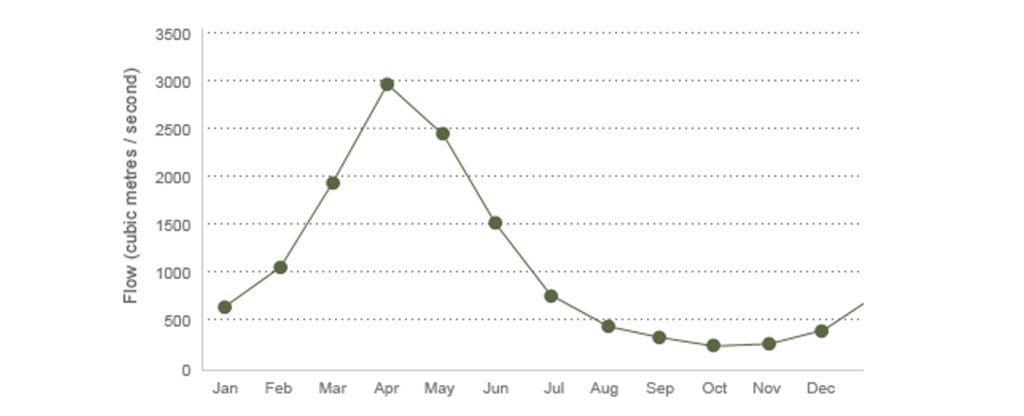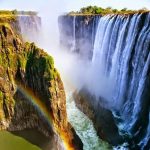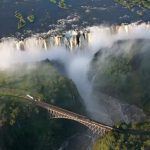Planning a trip to Victoria Falls? Wondering when is the best time to visit? Look no further as this article provides all the information you need to make the most of your trip. Whether you’re a fan of cascading waterfalls, thrilling adventures, or breathtaking sunsets, the best time of year to visit Victoria Falls has something extraordinary for everyone. From the thunderous flow of the falls during the rainy season to the dramatic beauty of the dry season, discover when to go to this wondrous wonder of nature.

Rainy Season
Introduction
The rainy season at Victoria Falls is a magical time of year when the mighty Zambezi River swells with water, creating the world’s largest waterfall in full force. From November to April, the rainy season brings lush greenery, vibrant flowers, and a dramatic display of nature’s power. While some may shy away from the rainy season due to the increased water volume and unpredictable weather, this is a unique opportunity to witness the falls at their most impressive.
Months
The rainy season spans from November to April, with the peak rainfall occurring between December and February. During this time, the falls are at their most magnificent, with the full force of the Zambezi River pouring over the cliffs. The months leading up to and following the peak rainfall still offer a stunning display, albeit with slightly lower water volume.
Water Volume
The rainy season brings a significant increase in water volume at Victoria Falls. The falls reach their peak flow in April, with an astonishing average of 500 million liters of water cascading down the gorge every minute. This surge of water creates a thunderous roar and generates an impressive spray that can be seen from miles away. Be prepared to get wet if you’re visiting during this time, as the mist from the falls often creates a refreshing shower for visitors.
Activities
The rainy season presents unique opportunities for adventure and awe-inspiring experiences. While some activities may be restricted due to safety concerns, others become even more exhilarating. White water rafting, for example, reaches its peak during this time, offering adrenaline junkies the ultimate thrill. Additionally, helicopter tours provide a breathtaking perspective of the falls and the surrounding green landscape. Exploring the rainforest that forms around the falls is also a must-do activity, as the vibrant foliage and the sounds of nature create an enchanting atmosphere.
Dry Season
Introduction
The dry season at Victoria Falls extends from May to October, offering a striking contrast to the rainy season. This period is characterized by lower water volume, clear skies, and cooler temperatures. While the falls may not be at their most impressive during this time, the dry season provides its own unique experiences that are equally captivating.
Months
The dry season begins in May and lasts until October, with September and October being the driest months. During these months, the falls gradually decrease in flow, revealing the underlying rock formations and allowing for a clearer view of the falls’ intricate details.
Water Volume
As the dry season progresses, the water volume at Victoria Falls gradually decreases. In October, the falls may reduce to a mere trickle in some sections, providing a rare opportunity to explore the rocky landscape that is normally hidden beneath the cascading water. Despite the decreased flow, the falls still maintain their stunning beauty, offering a different perspective that highlights their grandeur.
Activities
With lower water levels, certain activities become more accessible and thrilling during the dry season. Devil’s Pool, a natural rock pool on the edge of the falls, becomes a popular attraction during this time. Visitors can swim to the edge and peer over the sheer drop, experiencing an adrenaline rush like no other. Walking along the Knife-Edge Bridge also becomes possible, providing a closer look at the falls and the opportunity to capture incredible photographs. Game drives in the nearby national parks are also a fantastic way to appreciate the diverse wildlife that thrives in the dry season.

Shoulder Seasons
Introduction
The shoulder seasons at Victoria Falls occur between the rainy and dry seasons, offering a balance between water volume and favorable weather conditions. These transitional periods, known as the “shoulder seasons,” provide a unique opportunity to enjoy the best of both worlds.
Months
The shoulder seasons encompass the months of November and April, just before and after the peak rainfall. During this time, the falls are still impressive but not at their highest volume or flow rate. The weather is generally pleasant, with warm temperatures and occasional showers, making it an ideal time to explore the falls and engage in various activities.
Weather
The shoulder seasons boast pleasant weather conditions, with mild temperatures and a mix of sunshine and rain. The average temperatures during these months range from 20 to 30 degrees Celsius (68 to 86 degrees Fahrenheit), creating a comfortable environment for outdoor adventures. It’s important to note that humidity levels can be higher during this time, so be prepared for occasional downpours and pack accordingly.
Water Volume
While not at their peak, the shoulder seasons still offer a considerable amount of water flow. This allows visitors to witness the falls in all their glory without being overwhelmed by the immense spray and mist that accompanies the rainy season. It’s a perfect balance for those who prefer a softer experience while still appreciating the magnificence of Victoria Falls.
Activities
The shoulder seasons provide a wide range of activities to suit every interest and comfort level. Popular options include guided tours of the falls, where knowledgeable guides provide insights into the geological and cultural significance of the area. Boat cruises on the Zambezi River offer a serene way to enjoy the landscape and spot wildlife along the banks. For the more adventurous, activities like zip-lining, bungee jumping, and gorge swinging are available year-round and allow for an adrenaline-packed experience in the midst of natural splendor.
Hot Season
Introduction
The hot season at Victoria Falls, which occurs during the Southern Hemisphere’s summer months, offers a unique experience for visitors seeking warmer temperatures and vibrant landscapes. This time of year is perfect for those who enjoy the heat and want to bask in the sun while immersing themselves in the beauty of the falls and its surroundings.
Months
The hot season spans from October to February, with December and January being the hottest months. During this time, temperatures can soar as high as 40 degrees Celsius (104 degrees Fahrenheit), creating a tropical atmosphere that adds to the allure of Victoria Falls.
Temperature
As the name suggests, the hot season brings scorching temperatures to the area. While the heat may be intense, it also enhances the beauty of the falls by creating magnificent rainbows in the mist and casting a golden glow over the landscape. Embrace the warmth by wearing light clothing, staying hydrated, and taking advantage of shady spots and cooling activities.
Water Volume
Despite being called the hot season, this period still experiences occasional rainfall, contributing to the water volume at Victoria Falls. While the falls may not be at their peak flow, they maintain an impressive display, offering respite from the heat and creating a refreshing atmosphere.
Activities
The hot season provides an excellent opportunity to enjoy various water-based activities and outdoor adventures. Taking a dip in the natural rock pools, such as Devil’s Pool, is a must to cool off and get a unique perspective of the falls. Sunset cruises along the Zambezi River offer a delightful way to unwind and witness the vibrant colors of the sky as the day transitions into the evening. Other activities, such as canoe safaris and game drives, allow visitors to explore the wildlife-rich surrounding areas while enjoying the warm weather.

Cool Season
Introduction
The cool season at Victoria Falls offers a welcome relief from the scorching heat, with mild temperatures and pleasant conditions that are perfect for outdoor exploration. This period, which occurs during the Southern Hemisphere’s winter months, showcases a different side of the falls and its surrounding landscapes.
Months
The cool season spans from May to September, with July and August being the coolest months. During this time, temperatures range from 10 to 25 degrees Celsius (50 to 77 degrees Fahrenheit), providing a comfortable climate for visitors to enjoy their adventures.
Temperature
The cool season brings milder temperatures to Victoria Falls, making it ideal for those who prefer a more temperate climate. The cooler mornings and evenings create a refreshing ambiance, while the daytime temperatures allow for pleasant outdoor activities without the discomfort of intense heat. Layering clothing is recommended to accommodate the temperature fluctuations throughout the day.
Water Volume
During the cool season, the falls exhibit lower water volume compared to the rainy season. However, this does not diminish their beauty; in fact, it highlights the intricacies of the underlying rock formations and the dramatic contrast between the cascading water and the surrounding landscape. The falls still possess a captivating charm, albeit with a touch of tranquility.
Activities
The cool season at Victoria Falls invites visitors to engage in a variety of activities that are enjoyable in the mild weather. Walking along the trails that lead to various viewpoints is a popular choice, allowing for a leisurely exploration of the falls and the rainforest that surrounds them. Helicopter tours provide an unforgettable aerial perspective, showcasing the falls from above and highlighting the vastness of the Zambezi River. Wildlife enthusiasts can embark on game drives, as this time of year provides excellent opportunities to spot animals in the national parks nearby.
Crowds and Travel Costs
Introduction
Understanding the peak season, low season, and shoulder seasons at Victoria Falls is crucial for planning your visit while keeping crowds and travel costs in mind. Each season offers unique experiences, and considering these factors can greatly enhance your trip while optimizing your budget.
Peak Season
The peak season at Victoria Falls coincides with the dry season, particularly during the months from June to August when the weather is favorable and the falls are at a lower water volume. This period attracts a large number of tourists, leading to crowded viewpoints and popular attractions. While the larger crowds may be a downside for some, it also creates a bustling atmosphere and an opportunity to meet fellow travelers from around the world.
Low Season
The low season at Victoria Falls occurs during the rainy season, particularly from November to March. During this period, visitor numbers decrease significantly, resulting in a more relaxed and intimate experience. While the rainy season may deter some travelers, it offers the chance to witness the falls in their full splendor and at a lower cost.
Shoulder Seasons
The shoulder seasons, which include the transitional months of April, May, September, and October, offer a balance between low and peak season crowds. These months attract moderate visitor numbers, providing a pleasant and less crowded experience compared to the peak season while still offering favorable weather conditions and a range of activities.
Travel Costs
Travel costs at Victoria Falls can vary based on the season and demand. The peak season tends to be more expensive, with higher rates for accommodations, flights, and activities. Conversely, the low season offers more affordable options and discounted rates, allowing budget-conscious travelers to explore the falls while saving money. The shoulder seasons often present a balance between reasonable prices and optimal weather conditions, making it an attractive option for those seeking a combination of value and experiences.

Best Time for Adventure Activities
Introduction
Victoria Falls is a haven for adventure enthusiasts, offering adrenaline-pumping activities that cater to every thrill-seeker’s desires. Whether you’re a fan of white-water rafting, bungee jumping, or exploring from above in a helicopter, there’s an adventure activity to suit your tastes. Here’s a breakdown of the best times of the year for each adrenaline-filled experience.
White Water Rafting
For the ultimate white-water rafting experience, the best time to visit Victoria Falls is during the rainy season from November to April. The increased water volume during this time creates exhilarating rapids and an adrenaline-filled ride down the Zambezi River. Be prepared to get soaked and experience the rush of conquering the rapids at their most ferocious.
Bungee Jumping
Bungee jumping at Victoria Falls is an iconic activity that attracts thrill-seekers from around the world. The optimal time for this heart-pounding adventure is during the dry season from May to October. With lower water levels, the jump from the Victoria Falls Bridge is even more awe-inspiring and offers a breathtaking view of the gorge below.
Helicopter Tours
If you prefer to experience the falls from above, helicopter tours are a fantastic option. These tours provide a bird’s-eye view of the falls and the surrounding landscape, offering unparalleled perspectives and photo opportunities. Whether you choose to visit during the rainy or dry season, helicopter tours are available year-round, allowing you to capture the beauty of Victoria Falls from a unique vantage point.
Microflights
For an even more intimate and exhilarating aerial adventure, microflights are the way to go. These small, lightweight aircraft provide a thrilling experience as you soar through the air, getting up-close and personal with the falls and the Zambezi River. Microflights are available throughout the year, allowing you to choose the season that best suits your preferences.
Canoeing Safaris
For nature lovers and wildlife enthusiasts, canoeing safaris offer an immersive experience that combines adventure with wildlife encounters. The best time for canoeing safaris at Victoria Falls is during the dry season when water levels are lower and the wildlife congregates near the riverbanks. This allows for excellent game viewing opportunities while enjoying a serene and picturesque paddle along the Zambezi River.
Game Drives
To witness the incredible diversity of wildlife that calls the area around Victoria Falls home, game drives are a must. These guided tours take you deep into the national parks surrounding the falls, allowing you to spot animals such as elephants, lions, and giraffes in their natural habitat. Game drives are available year-round, with the dry season offering excellent visibility and increased chances of wildlife sightings.
Wildlife Sightings
Introduction
Victoria Falls is not only famous for its awe-inspiring waterfall but also for the abundance of wildlife that roams its surrounding landscapes. From elephants bathing in the Zambezi River to the majestic African lion, this region is a prime destination for wildlife enthusiasts. Understanding the best times to visit for optimal wildlife sightings can greatly enhance your safari experience.
Dry Season
The dry season at Victoria Falls, particularly from May to October, is the ideal time to witness an array of wildlife. As water sources become scarce outside the Zambezi River, animals congregate near the riverbanks to drink and cool off, creating fantastic opportunities for game viewing. The lower vegetation during this time also improves visibility, allowing for clearer sightings of animals in their natural habitat.
Rainy Season
Contrary to popular belief, the rainy season brings its own advantages for wildlife sightings. From November to April, the lush greenery and abundance of water sources attract a wide variety of animals to the area. Species such as impalas, zebras, and elephants are more easily spotted during this time as they graze on the fresh vegetation. Additionally, bird enthusiasts will be delighted by the influx of migratory bird species that arrive in the region during the rainy season.
Shoulder Seasons
The shoulder seasons offer a harmonious blend of dry and rainy season characteristics, resulting in a diverse wildlife sightings experience. The transitional months of April, May, September, and October provide opportunities to witness the tail end of the rainy season and the beginning of the dry season. This overlap allows for a wide variety of wildlife sightings, making the shoulder seasons an excellent choice for those seeking balance and diversity.
Best Months
While wildlife can be spotted throughout the year, the months of July to October are considered the best for game viewing at Victoria Falls. During this period, the dry season is in full swing, resulting in animals congregating near the riverbanks and providing fantastic sightings. The warm weather and clear skies during these months offer optimal conditions for unrivaled wildlife experiences.
Migration Patterns
One of the most remarkable wildlife spectacles at Victoria Falls is the migration of various species. During the dry season, elephants move from the drier areas to the riverbanks in search of water, creating incredible sightings of these majestic creatures. Additionally, the Kasane Elephant Corridor allows for the free movement of elephants between Zimbabwe, Botswana, and Namibia, providing a unique opportunity to witness this impressive migration.

Cultural Events and Festivals
Introduction
Immerse yourself in the rich cultural heritage of Victoria Falls by experiencing the vibrant festivals and traditional ceremonies that take place throughout the year. From rainmaking rituals to Independence Day celebrations, these events offer a unique glimpse into the customs and traditions of the local communities.
Rainmaking Festival
The Rainmaking Festival, also known as the “Mosi-oa-Tunya National Park Rainmaking Ceremony,” is a significant event that celebrates the region’s cultural heritage. Held during the rainy season, usually in February, this ceremony involves traditional rituals performed by the local Tonga people to request rainfall for the upcoming farming season. Witnessing the Rainmaking Festival offers a fascinating insight into the spiritual beliefs and practices of the local community.
Traditional Ceremonies
Throughout the year, various traditional ceremonies take place in the villages surrounding Victoria Falls. These ceremonies often involve music, dance, and storytelling, showcasing the cultural diversity and ancestral beliefs of the local tribes. While the specific dates and details of these ceremonies may vary, it is possible to arrange visits to villages and experience these captivating traditions firsthand.
Independence Day Celebrations
Independence Day, celebrated on April 18th, holds great significance for Zimbabwe and marks the country’s liberation from colonial rule. Victoria Falls joins in the national celebrations with vibrant parades, music concerts, and cultural performances. This is a joyful and patriotic time to visit the falls and witness the unity and pride of the local community.
Cultural Experiences
Aside from specific festivals and events, cultural experiences can be enjoyed year-round at Victoria Falls. Engaging with local artisans and visiting craft markets allows you to appreciate the traditional arts and crafts of the region. From intricate wood carvings to vibrant paintings, these locally produced items offer a tangible connection to the cultural heritage of Victoria Falls. Additionally, guided tours of the nearby villages provide opportunities to interact with locals, learn about their customs, and gain a deeper understanding of their way of life.
Photography Opportunities
Introduction
With its breathtaking landscapes, abundant wildlife, and powerful waterfalls, Victoria Falls is a paradise for photographers. From capturing the misty cascades to wildlife encounters, this region offers endless opportunities to hone your photography skills and create stunning images.
Rainy Season
The rainy season provides unique photography opportunities, particularly for capturing the falls in their full glory. The increased water volume results in a dramatic display of raw power, allowing you to capture the immense force of the Zambezi River plunging over the cliffs. The mist and spray create ethereal scenes and rainbows that add a touch of magic to your photographs. Utilizing long exposure techniques can enhance the drama of the falls, creating a sense of movement and energy.
Dry Season
The dry season at Victoria Falls offers a different perspective for photographers. With lower water levels, the underlying rock formations are revealed, presenting an opportunity to capture the intricate details and textures of the falls. The clear skies and golden light during sunrise and sunset create a warm and serene atmosphere, adding depth and richness to your images. Photographing wildlife in their natural habitat is also rewarding during the dry season, as the animals gather near the riverbanks and open spaces.
Sunrise and Sunset
The sunrise and sunset at Victoria Falls are truly breathtaking and provide photographers with magical lighting and color palettes. Position yourself at strategic viewpoints to capture the first rays of sunlight filtering through the trees or the vibrant hues of the sky as the sun sets behind the falls. These magical moments offer the opportunity to create stunning silhouettes, play with shadows, and capture the sheer beauty of the landscape during the golden hour.
Rainbows and Mist
The spray and mist generated by the falls create mesmerizing rainbows that add a touch of enchantment to your photographs. Position yourself at viewpoints that offer a clear line of sight to capture the full arc of the rainbow against the backdrop of the falls. Utilizing a polarizing filter can also help enhance the vibrancy of the colors and reduce glare caused by the mist. Experimenting with different angles and perspectives can yield unique and awe-inspiring images.
Wildlife Photography
Victoria Falls is teeming with a diverse array of wildlife, providing endless opportunities for captivating wildlife photography. From elephants, giraffes, and zebras to lions, leopards, and hippos, the surrounding national parks offer an abundance of subjects to capture. The dry season, when animals congregate near the riverbanks, is particularly rewarding for wildlife photography. Patience, observation, and respecting the animals’ space are key to capturing their natural behavior and unique personalities.
Bird Watching
Bird enthusiasts will delight in the wide range of avian species that call Victoria Falls home. From majestic raptors like the African fish eagle to vibrant social weavers and lilac-breasted rollers, the region boasts an array of colorful and striking birds. The diverse habitats, including wetlands, rainforest, and open savannah, support a rich birdlife that provides endless opportunities for bird photography. Packing a telephoto lens, binoculars, and a field guide will enhance your bird-watching and photography experience.
In conclusion, Victoria Falls offers a plethora of experiences throughout the year, each season showcasing its unique attributes. Whether you visit during the rainy season to witness the falls’ full power, the dry season for more intimate encounters with wildlife, or the shoulder seasons for a balanced experience, Victoria Falls will leave you in awe of its natural beauty, cultural heritage, and adventurous spirit. Capture the essence of this extraordinary destination through your photographs, immerse yourself in its rich culture, and embrace the opportunity for exhilaration and tranquility that can be found in every season.













